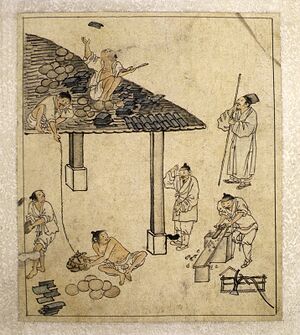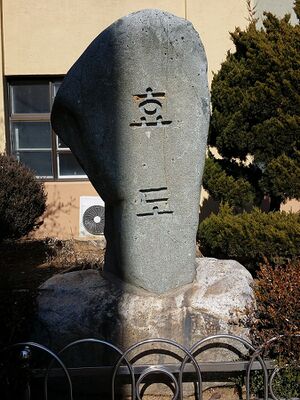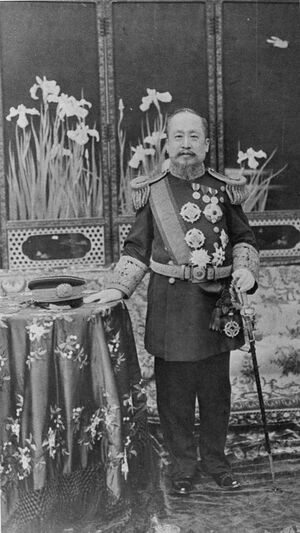User:Bohye Woo/Thesis Chapter 1
Topic
Free labour in the context of data colonialism
Question
What has been inherited in Korean working culture from Japanese colonialism, and how has this been transformed to a digital space? Through unpacking the inherited digital colonialism, free labour is produced — how can we make it palpable?
Body
Chapter 1: How did free labour arise in its cultural context? (2000)
Introduction (200)
It needs to be written.
Point A: South Korean labour — Korean work ethics is all about age hierarchy, work productivity, and forceful culture (800)
1. How was old Korean traditional way of working? (230)
In the past, there was the oldest communal laboring custom in Korean agricultural society called '품앗이(Pumasi)', a combination of the words pum which means 'working', and asi means 'repayment'. It consisted in working together for the benefit of the community, without taking into account the value of each other's labour contribution. This form of voluntary work makes neighbours gathered together to achieve a common goal with helps. It emphasizes on the positive side of a give and take relationship where they don't make an official contract to precisely define a 50:50 relationship. Here we can also refer to a Korean human affection concept called '정(jeong)', an emotional and phychological bonds that joins Koreans. 'Jeong' is considered as a kind of unique love, you can help someone without asking for the compensation, giving something extra than you promised to because you are emotionally attached to the person you are helping to. Additionally, a piece of music was sung while conducting a task to make work effective, this gesture is called '노동요(No-Dong-Yo)'. The concept of No-Dong-Yo is to work together with a certain rhythm of labour and work together with a little effort. Moreover, it is sung in order to keep the unity of working behavior and to work efficiently. In this sense, old working culture in Korea was about helping each other, working together in a productive way.
2. How has the traditional working method transformed into the modern working culture in Korea? (260)
What is the modern way of working like in S. Korea? In contrast to the traditional working culture where hard-work was a positive activity to help each other, it has remained [working remains? a bit unclear] a negative remnant in modern society. According to the Korea Herald, South Koreans are known to be among the world's worst workaholics, ranking second in the OECD in terms of working hours in 2014 (OECD, 2014). As stated in OECD, the average S. Korean worked 2,163 hours in 2014, which means that they worked 1,3 times more hours than workers outside of Korea. The figure includes part-time workers and those who work for part of the year, as well as full-time employees. This means they work 271 days per year on the assumption that the average is 8 hours per day. However, many companies encourage to start working from 8:30 to 19:30, therefore the actual working hours per day is comparably longer than other countries. Plus, many workers work over-hours in the evening so that they tend to stay at work till early in the morning. Nonetheless, they earn less-than-average wages compared to other nations in the same job group. In fact, these long hours start at a young age, with Korean children often spending as much as 14 hours a day in a classroom between regular school and private, afternoon academies called 'Hagwon's (Kasulis, 2017). This means the schools in Korea start around 8:30 in the morning and finish around 18:00, and then extra 'Hagwon's in the evenings until approximately 22:00.
3. Why does Korean work overtime to produce free labour? because of Age hierarchy, work productivity and forceful culture (450)
Why do Koreans work overtime, even young kids? In order to understand why, we need to consider looking at working culture customs in Korea. What are the working customs in the specific context in S. Korea? And more specifically, how does that affect the creation of free labour in Korean working culture?
3-1: Age Hierarchy
There are a few reasons why Koreans work so hard at school and work. First of all, it stems from the culture of age hierarchy. In general, Korean society is based on age hierarchy in which older people get more respect, are treated better, earn more money and get fame. It is true that when it comes to the work environment, age matters much more than skill if two people have similar skills and experience. If you've freshly started working in a company and you are the youngest one in the group, you become the one who always serves morning coffees to the team members. It is shown between family members as well through 'Filial Piety' which is a virtue of respect for one's parents, elders, and ancestors. Through this concept, Young childrens need to be good to their parents and they can't answer back to the older family. This idea of Filial Piety present in Confucianism, literally means the "family of scholars" signifying a genealogy, a tradition of learning that was created in China. Although its origin from China, much of Confusian culture remains in practice in Korea. (Tu, 1998) There are important parts of Confucianis in the five relationships "오륜", among the five relationships, these two relationships are related to Korean age hierarchy culture: '부자유친' (Bu-Za-Yu-Chin) (父子有親) — Father and son must have closeness/intimacy, and '장유유서' (Jang-Yu-Yu-Seo) (長幼有序) — Old and young (siblings) have an order/sequence. The first relationship defines how you should listen to your father because they give birth to you, and the second one stresses that there should be an order between youngers and olders because the older ones might have more wisdom and are a better person.
3-2: Forceful culture
Another reasons why Koreans work hard is derived from a forceful working culture. There are several ways of forcing workers to work in Korea, one of it is a Korean drinking culture called "Hoe-Sik". It literally means “dinners with coworkers”, the gatherings often associates heavy drinking as well as stays at karaoke bars where colleagues were expected to entertain those higher positioned collegues, such as your seniors. This working and drinking culture tend to bring a '과로사' "Gaw-Ro-Sa", death by overworking from company, which concludes that South Korea’s work culture is notorious for its rigid hierarchy, forceful, demand for obedience and loyalty, and work hours. (Park, 2017)
In contrast to the Korean traditional way of working based on the Korean concepts '정(jeong)' and '노동요(No-Dong-Yo)' where it was about helping each other, working together to reduce the overload of work in a productive way, age hierarchy and forceful culture in Korea makes workers work longer hours, which hinders employees from directly contributing to the achievements of a business.(Shin, 2018)
Point B: Over-working hour culture came from the Japanese colonial times as well as military regime period. (1000)
Introduction
Where does age hierarchy and forceful culture, that makes Korean hard workers, originate from? To understand why there is S. Korean free labours culture, we need to go back to the history of S. Korea in the early 20th century. In the history of S. Korea where they were colonized by Japan during the 1905 — 1945, this chapter presents what culture has been inherited from the history that affected to the modern Korean working society.
Title goes here
Back to the history of Korea in 1910 — 1945, Korea have long been preoccupied with the economic impact of development and exploitation from Japan. (Ha, 2012) Around that time in the late 1890s, Korea had no power as an individual country where the 26th king of the Joseon Dynasty, Go-Jong, was portraited as a lethargic sackless king from Japanese's perspective. (Ham, 2017) This eventually made him to abdicate a throne and Korea started becoming a colony of Japan who entered into capitalism as industrialization. At that moment, Japan resolved to open up their country and accelerated the industrialization process, which led to its rise as a military power by the year 1895. (Tadashi, 2019)
<------------------------------------------ from here I have to re-write ------------------------------------------>
Relation to the Japanese colonial times
A culture of hierarchy and high pressure to work long hours is coming from the uniquely hierarchy-driven work culture that was influenced by the Japanese work values during the colonial period in the early 20th century. (a)There is a concept of 'Myeol-Sa-Bong-Gong(멸사봉공)' as a vestige of Japanese imperialism which means "destroy your personal life and devote yourself for the betterment of your community". The concept encouraged people to safrifice their personal life for the companies they worked for, and such a life was viewed as ideal and even honorable. Today's work culture in S. Korea certainly has traits that were influenced by this concept. (The Korean Herald, 2015) (There are more references such as forceful labour during the colonial era, how their labour was being used, how much they actually worked per day.) (b) During the occupation, Japan took over Korea’s labor and land. Nearly 100,000 Japanese families settled in Korea with land they had been given; they chopped down trees by the millions and planted non-native species, transforming a familiar landscape into something many Koreans didn’t recognize.
Relation to the military regime period
It also came from the military-driven culture that dominated S. Korea under the authoritarian governments of the 60s and 70s. (The Korean Herald, 2015) Since the establishment of the South Korean state in 1948, twelve people have served nineteen terms as president of South Korea. Especially the second president of S. Korea named Park Chung-hee, who followed dictatorship for 16 years (1963 ~ 1979). He was a Japanese collaborator and one-time communist who cynically engineered a path to the top. He was a sinister general who seized power via coup. He suppressed democratic institutions, wielded security services to suppress human rights and altered the constitution to maintain power. (There will be more references such as, how he performed his dictatorship when it comes to using labours.)
Chapter 1 Conclusion:
Korean working culture is a toxic legacy of colonialism and militarism from the early 20th century which brought the concept of free labour. This is a remnant of Japanese colonialism and military dictatorship that permeated in our skin, and it persisted for a long time.
References
South Korea’s play culture is a dark symptom of overwork — Quartz(n.d.). Available at: https://qz.com/1168746/south-koreas-play-culture-is-a-dark-symptom-of-overwork/(Accessed: 16 November 2019).
[Weekender] Origins of Korean work culture - The Korea Herald(n.d.). Available at: http://www.koreaherald.com/view.php?ud=20150116001008&ACE_SEARCH=1(Accessed: 16 November 2019).
Samson·Asia·March 27, C. and Read, 2018·3 Min (2018) Korea Has a Unique Kind of Love That is Extremely Difficult to Explain to Foreigners. Available at: https://nextshark.com/jeong-korea-unique-kind-love-extremely-difficult-explain-foreigners/(Accessed: 2 December 2019).
품앗이 - 한국민족문화대백과사전(n.d.). Available at: http://encykorea.aks.ac.kr/Contents/Index?contents_id=E0060329(Accessed: 2 December 2019).
Tu, W. M. (1998), "Confucius and Confucianism", in Slote, Walter H.; Vos, George A. De (eds.), Confucianism and the Family, SUNY Press, pp. 4, ISBN 978-0-7914-3736-0
Lee, Hong Yung, Yong-ch’ul Ha, and Clark W. Sorensen, eds. Colonial Rule and Social Change in Korea, 1910-1945. Seattle: Center for Korea Studies Publication, University of Washington Press, 2013.
Ham, G. J. (2017). "한국인이 알아야 할 조선의 마지막 왕, 고종", 자음과모음 press, ISBN 9791187858782
Karube, Tadashi, and David Noble. (2019). Yoward the Meiji Revolution: The Search for “Civilization” in Nineteenth-Century Japan = “Ishin Kakumei” e No Michi: “Bunmei” o Motometa Jūkyūseiki Nihon. First English edition. Japan Library. Tokyo, Japan: Japan Publishing Industry Foundation for Culture, 2019.
Caprio, M. (2009). Japanese Assimilation Policies in Colonial Korea, 1910–1945. University of Washington Press. pp. 82–83.



